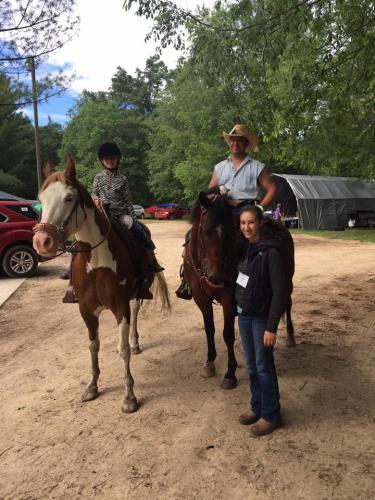Responsible trail riding tips
Discover ways to ride the trails responsibly.

If you’re spending time with your horse on the trail, it’s important to do so responsibly. Read on to discover many ways in which you can be sure that you ride responsibly.
Travel responsibly
- Stay on designated roads, trails and other areas open to horses.
- Ride single file to reduce trail damage. Spread out in open country where there are no trails. Spreading out, rather than following each other’s footsteps, disperses impact and avoids creating a new trail.
- Comply with all signs and respect barriers.
- Riders should match their skill level to the temperament and ability of the horse they ride. Learn more about selecting the appropriate horse for you.
- At trailheads or staging areas, park vehicles and secure horses in a manner that provides a safe distance between the horses and passing traffic.
- Less experienced horses and riders should ride behind more experienced horses and riders.
- Learn more about safety on the trail.
Respect the rights of others
- Be considerate of others on the road or trail.
- Be prepared to let other trail enthusiasts know what needs to be done to keep you, the horse and other passersby safe when you meet on the trail.
- Be alert and aware of the presence of other trail enthusiasts. If possible, pull to the side of the trail when you hear oncoming off-highway vehicles or bicycles.
- Leave gates as you find them. If crossing private property, be sure to ask permission from the landowner(s).
- Do not disturb historical, archeological or paleontological sites.
- Avoid “spooking” livestock and wildlife you encounter and keep your distance.
- Water animals in areas where stream banks and water access can withstand hard use and are downstream from campsites.

Educate yourself
- Obtain a map of your destination and determine which areas are open to your type of animals.
- Make a realistic plan and stick to it. Always tell someone of your travel plans.
- Contact the land manager for area restrictions, closures and permit requirements.
- Check the weather forecast for your destination. Plan clothing, equipment and supplies accordingly.
- Carry a compass or a Global Positioning System a (GPS) unit and know how to use it.
- Carry water and emergency supplies even on short trips.
- Keep groups small and carry lightweight gear to reduce the number of animals needed.
- Pre-plan camp locations that provide plenty of room and the proper environment for confining animals.
- Take responsibility for your horse’s education. Introduce it to vehicles and situations it may encounter on shared trails. You should do this as much as possible before taking your horse off your property.
Do your part
- Pack out what you pack in. Carry a trash bag and pick up litter left by others.
- Practice minimum impact camping by using established sites and camping 200 ft. from water resources and trails.
- When selecting a campsite, first consider your horses; the site should accommodate them without damaging the area.
- When breaking camp, remove or scatter manure, remove excess hay and straw, and fill areas dug up by animal hooves.
- Observe proper sanitary waste disposal or pack your waste out.
- Bring pellets, grain or weed-free hay to areas where feed is limited or grazing is not allowed. This helps reduce the spread of invasive species.
- Wash your gear and support vehicle and check your animal before and after every ride to avoid the spread of invasive species.
- Build a trail community. Get to know other types of recreationists that share your favorite trail.



 Print
Print Email
Email


